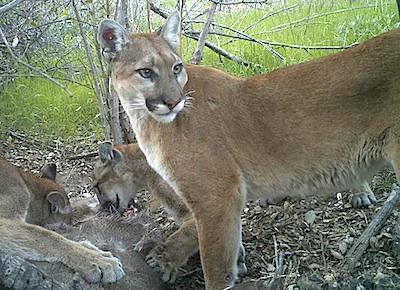
A mountain lion keeps watch while her juvenile cubs feed at a bait site. The mother, known to scientists as F92, is one of the two known offspring of the only male detected in the Santa Ana Mountains that genetically groups with lions east of Interstate 15. Busy highways and growing urbanization in the area threaten pumas in southern California and have led to their genetic decay, a UC Davis study found./UC Davis
A genetic sampling of more than 300 mountain lions in southern California, including within the Santa Monica Mountains National Recreation Area, shows the big cats lack genetic diversity.
Contributing to the problem are human development and freeways that offer few opportunities for safe crossings by mountain lions, according to the study led by the University of California, Davis, in partnership with The Nature Conservancy.
The study, published this past week in the journal PLOS ONE, represents the largest genetic sampling of mountain lions, or pumas, in southern California. It raises concerns about the current status of mountain lions in the Santa Ana and Santa Monica mountains, as well as the longer-term outlook for mountain lions across southern California.
For the study, UC Davis School of Veterinary Medicine scientists collected and analyzed DNA samples from 354 mountain lions statewide, including 97 from southern California. Pumas in the Santa Ana Mountains displayed lower genetic diversity than those from nearly every other region in the state, the researchers said.
Santa Ana mountain lions show dramatic genetic isolation and have less in common with their neighbors in the Santa Monica Mountains than with those in the Sierra Nevada, underscoring the increasing seclusion of pumas in Southern California.
The Santa Ana Mountain range, located south of Los Angeles and north of San Diego, is surrounded by urbanization and a growing population of about 20 million people. A small habitat linkage to the southeast connects pumas to the Peninsular Range, but it is bisected by Interstate 15 -- a busy 10-lane highway -- and associated human development. The study highlights the urgency to maintain and enhance the little connectivity remaining for coastal mountain lions, particularly across I-15.
The study also showed that the Santa Ana pumas recently went through a 'population bottleneck,' when the population's size sharply decreased to a fraction of its original size.
'The genetic samples give us a clear indication that there was a genetic bottleneck in the last 80 or so years,' said lead author Holly Ernest, a professor with the Karen C. Drayer Wildlife Health Center and the Veterinary Genetic Laboratory at UC Davis at the time of the study. She is now a professor at the University of Wyoming, Laramie. 'That tells us it's not just natural factors causing this loss of genetic diversity. It's us -- people -- impacting these environments.'
Pumas in the Santa Monica Mountains also are struggling with low genetic diversity, inbreeding, and lions killing other lions, according to a study co-authored by Ernest and published in September's issue of Current Biology. Just one lion was known to cross Highway 101 during the study period, and he significantly increased the genetic diversity of that population, the study found.
Winston Vickers, co-author of the PLOS ONE study and leader of the puma field study in southern California, said the studies help paint a conservation picture of the region and reinforce the idea that very little movement across the freeway is occurring.
'It's not just one isolated spot you can dismiss,' said Vickers, an associate veterinarian with the UC Davis Wildlife Health Center. 'It can happen anywhere. If we keep building without attention to these issues, we're going to keep creating more pockets of isolation where animals can no longer connect with each other.'
Study co-author Scott Morrison, science director for The Nature Conservancy in California, said the conservation implications of the highway barrier are serious.
'This study really highlights the impact a road can have on wildlife,' he said. 'The land-use decisions made along Interstate 15 over the next few years may well be fateful for lions in the Santa Ana Mountains.'
For a textbook example of why genetic diversity is important, look to the Florida panther. Loss of genetic diversity among the panthers had become so severe by the 1990s that panthers were having trouble reproducing. Several of those that did reproduce had babies with heart defects. Millions of dollars have since been spent on their slow recovery.
In addition to low genetic diversity, southern California pumas are threatened by habitat loss and fragmentation, and death from numerous causes including vehicles, depredation permits, poaching, disease, public safety kills, wildfire and poisoning. An elevated combination of these factors could be a tipping point for the population.
However, Ernest said it is not too late to protect the region's mountain lions.
'I think there could be hope for this population,' Ernest said. 'They're at a point where they can be monitored and protected. They don't have to end up like Florida panthers. With early interventions, we wouldn't have to spend millions and millions of dollars later.'
Possible measures could include protecting migration corridors and some lands slated for development that could connect the Santa Anas to areas in the east, as well as strategically installing protective corridors for the lions to navigate busy highways.
Other authors in the study include Michael Buchalski and Walter Boyce from the UC Davis School of Veterinary Medicine.



Add comment